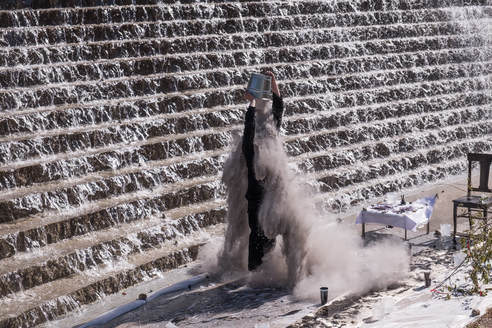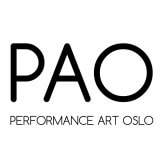Interview with Alistair McLennan
 Photo by Winston Inoway
Photo by Winston Inoway
July 2018
Q: Why / when / how did you start to work with performance, what is your background, how did you arrive at doing performance?
I started performing in 1971, after realizing traditional art forms were dominated by 'cultural real-estate' issues.
In Scotland I studied academic drawing, painting and sculpture, then took an MFA in painting and printmaking at the School of the Art Institute of Chicago, USA.
Q: What is your process like when you make a performance, from idea to actual work?
I look for inspiration from what's around me. This may come from discarded, overlooked material, suggesting evocative, unexpected re-usage, engaging entropy and new life, involving (so called) 'programmed chance' and final selection, from collected variables.
Q: Can you tell about your latest project?
It's still in process, being born.
Q: What role does performance art have in your life / artistic praxis? Do you also work within other fields, like installation, sculpture, drawing, and other expressions? How do they influence / inform each other?
'Performance' plays a major role, whether as solo, duo, or in 'group' form. I often make 'Actuations' (performance/installations). Different materials and techniques 'inter-fuse'.
Q: With what kind of form / material do you express yourself and use in your work and how did you arrive at using this material?
Materials vary in different performances. A few may re-appear... spectacles with one lens... red, green, black and white ribbons.
There's a difference between looking and 'seeing'. Cultural 'conditioning' can manifest through colour. Sound (or 'lack' of it) is what's heard. Technical requirements are kept to a minimum. Movement is still, slow and/or fluent...influenced by Zen practice.
Q: How do you experience or consider the audience / surrounding? What space / surrounding do you find interesting to work in? How does your surrounding influence your work? Do you involve the public? If so, how?
As Tarkovsky does. Raw nature and/or 'lived-in' space. Quality of 'inter-relations' constitutes the work. Public can be actively passive, or passively active.
Q: Make your own question, and answer it.
"Where would you go to get there?" A question implies it's own answer.
<< Back
Q: Why / when / how did you start to work with performance, what is your background, how did you arrive at doing performance?
I started performing in 1971, after realizing traditional art forms were dominated by 'cultural real-estate' issues.
In Scotland I studied academic drawing, painting and sculpture, then took an MFA in painting and printmaking at the School of the Art Institute of Chicago, USA.
Q: What is your process like when you make a performance, from idea to actual work?
I look for inspiration from what's around me. This may come from discarded, overlooked material, suggesting evocative, unexpected re-usage, engaging entropy and new life, involving (so called) 'programmed chance' and final selection, from collected variables.
Q: Can you tell about your latest project?
It's still in process, being born.
Q: What role does performance art have in your life / artistic praxis? Do you also work within other fields, like installation, sculpture, drawing, and other expressions? How do they influence / inform each other?
'Performance' plays a major role, whether as solo, duo, or in 'group' form. I often make 'Actuations' (performance/installations). Different materials and techniques 'inter-fuse'.
Q: With what kind of form / material do you express yourself and use in your work and how did you arrive at using this material?
Materials vary in different performances. A few may re-appear... spectacles with one lens... red, green, black and white ribbons.
There's a difference between looking and 'seeing'. Cultural 'conditioning' can manifest through colour. Sound (or 'lack' of it) is what's heard. Technical requirements are kept to a minimum. Movement is still, slow and/or fluent...influenced by Zen practice.
Q: How do you experience or consider the audience / surrounding? What space / surrounding do you find interesting to work in? How does your surrounding influence your work? Do you involve the public? If so, how?
As Tarkovsky does. Raw nature and/or 'lived-in' space. Quality of 'inter-relations' constitutes the work. Public can be actively passive, or passively active.
Q: Make your own question, and answer it.
"Where would you go to get there?" A question implies it's own answer.
<< Back
